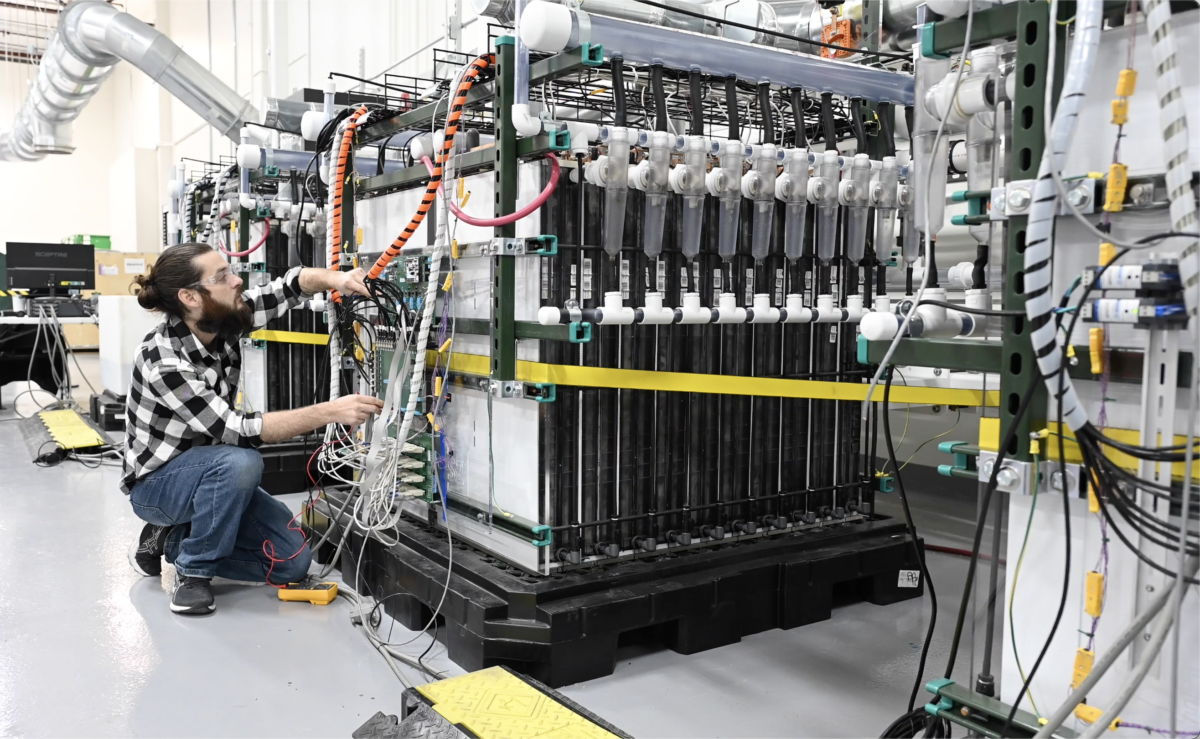Boston-based startup Form Energy recently announced it has been awarded a $12 million grant from the New York State Energy Research and Development Authority (NYSERDA) to deploy a 10 MW/1000 MWh pilot battery project in New York by 2026. This will be Form Energy’s first grid-scale project in the state following similar announcements in Colorado and Minnesota.
Form Energy’s iron-air battery technology can deliver 100 hours of discharge at system costs competitive with conventional power plants. The multi-day duration positions it well to help New York meet its ambitious clean energy targets – a clean grid by 2040.
NYSERDA awarded the grant as part of its $17 million long-duration energy storage program, intended to accelerate commercialization of promising long-duration technologies. New York has set a goal of 100% carbon-free electricity by 2040 and will need technologies like multi-day storage to ensure reliability during extended lulls in wind and solar generation.
“Our analysis indicates that multi-day storage has significant potential to help New York meet its decarbonization and grid reliability goals,” said Mateo Jaramillo, CEO of Form Energy. “This grant allows us to accelerate deployment of our first multi-day battery system in New York and sets the path for us to deliver further multi-day storage projects in the State in the future.”
An analysis recently released by Form Energy provides further evidence that multi-day energy storage like its iron-air technology can substantially reduce the costs for New York to achieve its ambitious decarbonization targets.
The analysis used advanced modeling techniques to compare multiple scenarios with varying availability of energy storage durations. It found that including both long-duration (10 to 24 hour) and multi-day (>24 hour) storage in the mix of resources available to meet New York’s goals reduces total system costs in 2040 by 29% compared to relying solely on short-duration lithium-ion batteries.
In the models with only short-duration lithium-ion batteries available, over 60 GW of battery capacity is built by 2040 to shift renewable generation and meet peak demand. However, this capacity only provides 538 GWh of energy storage.
Whereas when long-duration and multi-day storage are available, total storage capacity needs drop to around 40 GW. But critically, total energy storage capacity grows nearly 10x to over 5,000 GWh. These large energy reserves allow the grid to smooth multi-day variability in renewable generation. The emphasis on iron-air storage also avoids the potential fire-hazard of lithium batteries. According to Julian Spector at Canary Media, three separate fires at lithium battery facilities in New York owned by Nextera and Convergent Energy have left the state’s Governor Hochul scrambling to assure local residents that the transition to a clean grid is safe and healthy.
Models show 35 GW of multi-day storage capacity is optimal by 2040. This includes 19 GW of iron-air batteries (or equivalent) plus 16 GW of hydrogen storage. In tandem with 4 GW of lithium-ion batteries and pumped hydro storage, this diverse portfolio of storage durations provides the flexibility to shift renewable energy across multiple timescales.
Multi-day storage charges during periods of excess renewable generation and then discharges steadily for days or weeks during extended lulls, effectively firming the variable output. For example, during one modeled offshore wind lull, wind generation was only 33% of average for a full week. Multi-day storage supplied 16% of total demand that week by drawing from its vast energy reserves.
This ability to firm renewable generation translates into major cost savings. With multi-day storage available, models show New York’s 2040 electric system can be decarbonized with 22% less lithium-ion storage capacity, 36% less nuclear generation, and 6% less solar capacity. The 29% cumulative cost reduction underscores the value provided by long-duration and multi-day storage.

Source: Form Energy
Additionally, the avoided build-out of solar, nuclear and short-duration batteries reduces land use needs and transmission investments. So multi-day storage confers environmental benefits as well as direct economic savings.
The analysis shows long-duration storage begins providing significant value as early as 2030. Including 4.8 GW of multi-day storage in 2030 resource plans reduces costs by 6% annually, while avoiding the need for 5 GW of <10 hour batteries and 5 GW of solar generation. This demonstrates near-term policy support will be crucial to accelerate deployment of emerging long-duration storage technologies in the next 5-7 years.
Overall, the white paper provides compelling evidence that long-duration and multi-day energy storage can cost-effectively firm New York’s growing renewable generation, ensuring a reliable grid during the transition to 100% carbon-free electricity. Form Energy’s iron-air battery is well-suited for this application and the NYSERDA grant will facilitate demonstration of a pilot system by 2026.
Looking ahead, Form Energy projects New York will require at least 3 GW per year of new multi-day storage capacity between 2030 and 2040. Near term policy action to establish incentives, market mechanisms and contract structures will give the private sector needed market signals to invest in manufacturing and project development for emerging technologies like iron-air batteries. Then these resources can be deployed at scale to maximize cost savings and grid reliability as New York pursues its ambitious decarbonization timeline.

Tim Montague leads the Clean Power Consulting Group and is host of the Clean Power Hour podcast. He is a solar project developer, cleantech executive coach and consultant, mastermind group leader, entrepreneur and technology enthusiast.
The views and opinions expressed in this article are the author’s own, and do not necessarily reflect those held by pv magazine.
This content is protected by copyright and may not be reused. If you want to cooperate with us and would like to reuse some of our content, please contact: editors@pv-magazine.com.








By submitting this form you agree to pv magazine using your data for the purposes of publishing your comment.
Your personal data will only be disclosed or otherwise transmitted to third parties for the purposes of spam filtering or if this is necessary for technical maintenance of the website. Any other transfer to third parties will not take place unless this is justified on the basis of applicable data protection regulations or if pv magazine is legally obliged to do so.
You may revoke this consent at any time with effect for the future, in which case your personal data will be deleted immediately. Otherwise, your data will be deleted if pv magazine has processed your request or the purpose of data storage is fulfilled.
Further information on data privacy can be found in our Data Protection Policy.